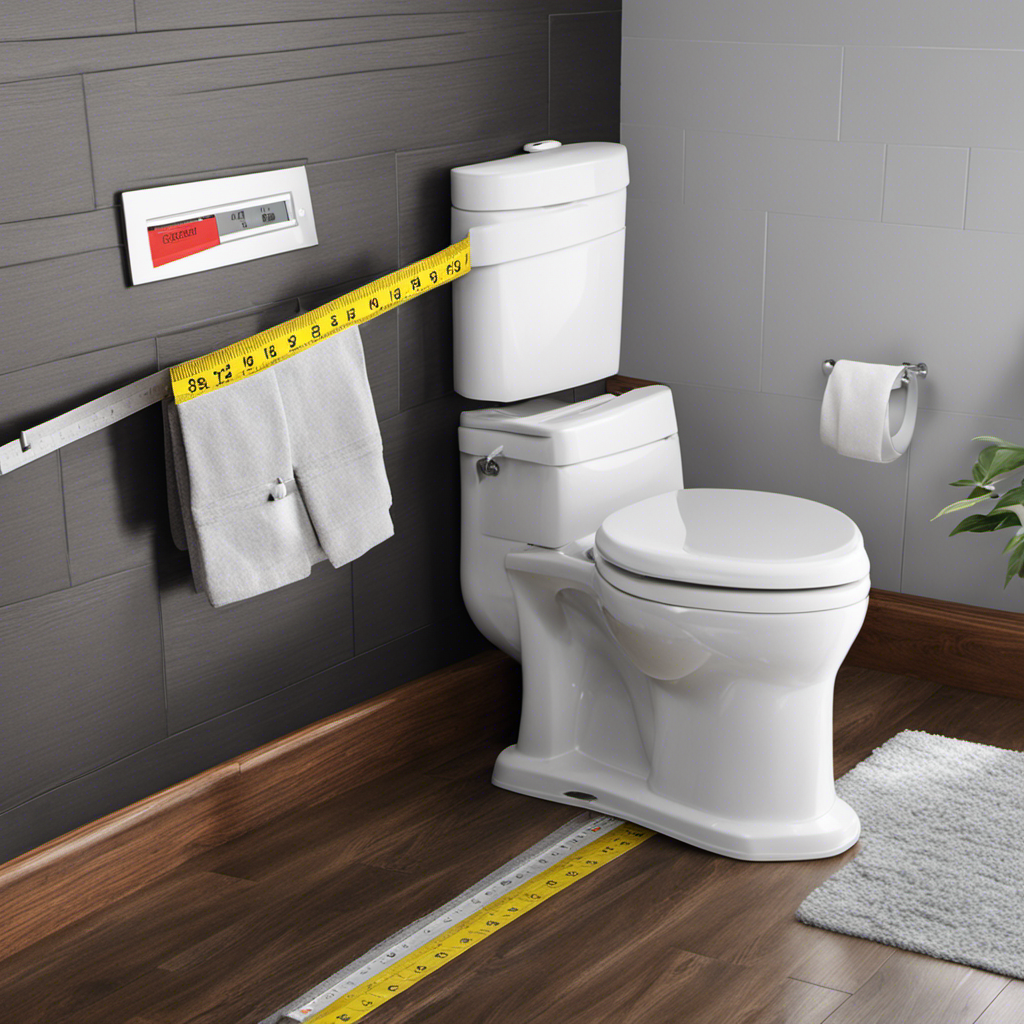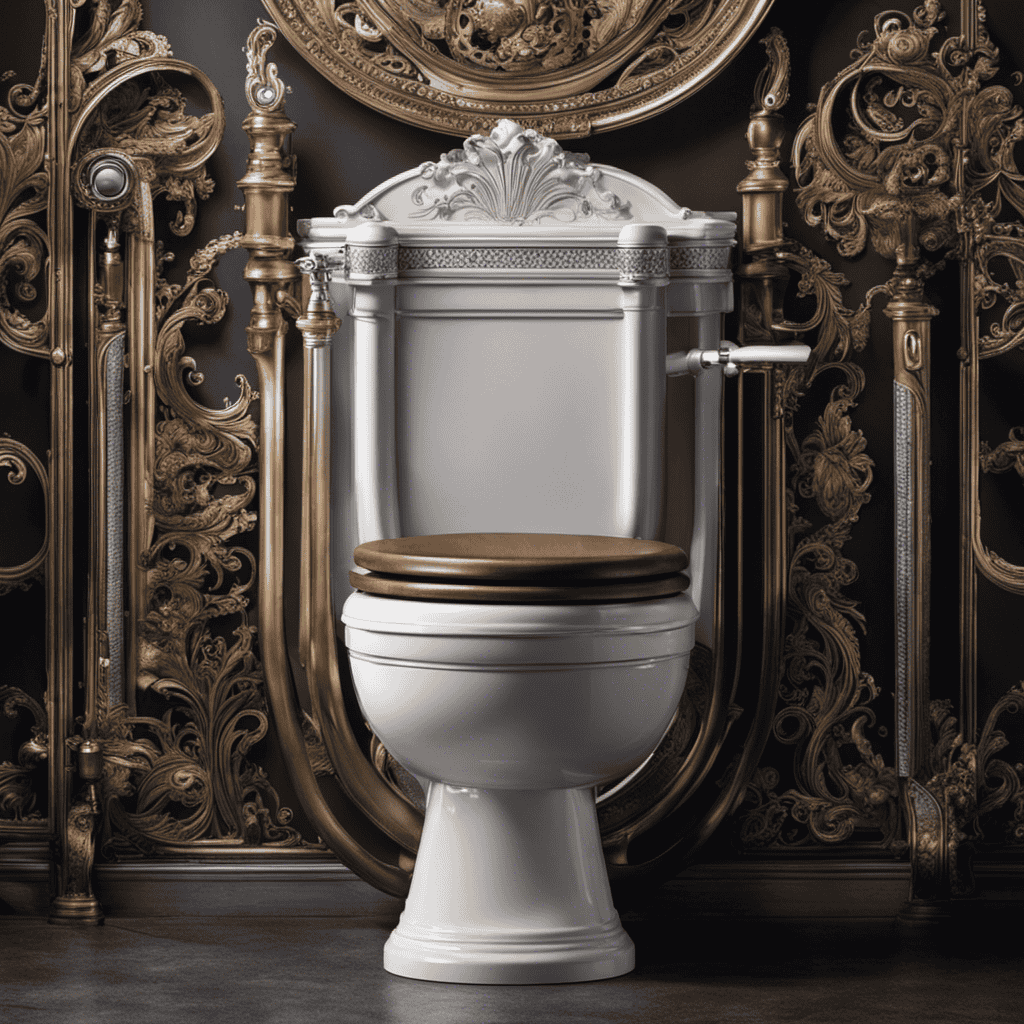I’m here to show you the ultimate way to measure a toilet. Get ready for the most precise, detailed, and technical instructions out there. No need to fret about getting it wrong – I’ve got you covered.
From measuring the length and width to determining the height and rough-in size, we’ll leave no stone unturned. And don’t worry, we’ll even cover the seat dimensions and tank size.
So grab your measuring tape and let’s dive in.
Key Takeaways
- Measuring the length, width, and height of the toilet is important for determining the correct size and fit.
- Understanding the tank capacity options available helps in making an informed decision about flushing power and water efficiency.
- Comparing flushing power and water efficiency of different tank capacity options helps in choosing the right one.
- Measuring the water volume in the toilet tank helps estimate potential water savings and guides decision-making for water conservation.
Measuring the Length of the Toilet
To measure the length of the toilet, you’ll need a measuring tape. Start by positioning yourself in front of the toilet, ensuring you have a clear view of the entire bowl and tank.
Extend the measuring tape from the back of the tank to the front edge of the bowl. Make sure the tape is taut and parallel to the floor for an accurate measurement.
Take note of the measurement in inches or centimeters. By measuring the depth of the toilet, you can compare it to other toilet sizes to find the one that best fits your needs.
Knowing the exact length of the toilet is crucial when it comes to purchasing a new one or making any renovations in your bathroom.
Determining the Width of the Toilet
When determining the width of a toilet, it is important to have the proper measuring tools on hand. A tape measure is essential for accurately measuring the width of the toilet bowl and tank. Additionally, a level can help ensure that the measurements are taken at a precise horizontal angle.
Common toilet widths can vary, but most standard toilets have a width of around 14 to 16 inches. However, there are also compact toilets available with narrower widths for smaller spaces.
Required Measuring Tools
You’ll need a tape measure to measure the dimensions of the toilet.
When it comes to measuring the bowl depth, it’s important to be precise. Start by locating the highest point of the inside rim and measure vertically down to the lowest point of the bowl. This will give you an accurate measurement of the bowl depth.
To calculate the flush capacity, you’ll need to measure the water level in the tank. Simply flush the toilet and mark the water level with a pencil. Then, measure the distance from the mark to the top of the tank. This will give you the flush capacity of the toilet.
Remember to record all measurements accurately, as they will be crucial when selecting a new toilet or making any necessary repairs.
Common Toilet Widths
Knowing the common widths of toilets can help you determine if a particular model will fit in your bathroom space. When it comes to toilet installation, size considerations are crucial to ensure a proper fit. Below is a table displaying the common widths of toilets:
| Standard Width (inches) | Compact Width (inches) | Elongated Width (inches) |
|---|---|---|
| 14-15 | 12-13 | 16-17 |
| 15-16 | 13-14 | 17-18 |
| 16-17 | 14-15 | 18-19 |
| 17-18 | 15-16 | 19-20 |
| 18-19 | 16-17 | 20-21 |
These measurements may vary slightly depending on the manufacturer and design. By comparing the available space in your bathroom with the dimensions of different toilet models, you can ensure a proper fit during installation. It’s essential to consider not only the width but also the length and height of the toilet to guarantee comfort and functionality.
Measuring the Height of the Toilet
To accurately measure the height of the toilet, it’s important to use a measuring tape and ensure the toilet is level. Start by measuring the dimensions of the toilet seat, from the top of the seat to the floor. This will give you the initial height of the toilet.
Next, determine the optimal toilet height by considering factors such as the user’s height and any physical limitations they may have. The standard toilet height is around 14 to 15 inches, but there are also comfort-height toilets available, which are taller and easier to sit on and stand up from.
Once you have determined the desired height, you can make adjustments by adding or removing toilet seat risers. Remember to always measure accurately and consider the individual needs of the user when determining the height of the toilet.
Calculating the Rough-In Size
Calculating the rough-in size is essential for ensuring the toilet will fit properly in your bathroom. To do this, you need to measure the distance between the finished wall and the center of the sewer drain pipe. This measurement will determine the rough-in size, which is typically 10, 12, or 14 inches.
Here are three reasons why calculating the toilet rough-in size is crucial:
-
Proper fit: By accurately measuring the rough-in size, you can ensure that the toilet will align perfectly with the sewer drain pipe, allowing for a proper fit and preventing any leaks or issues.
-
Efficient installation: Knowing the rough-in size beforehand will save you time and effort during the installation process, as you can choose a toilet with the appropriate rough-in size and avoid any modifications to the plumbing.
-
Aesthetics: A toilet that is not properly aligned with the sewer drain pipe can look unappealing and disrupt the overall aesthetics of your bathroom. Calculating the rough-in size ensures that the toilet is positioned correctly, enhancing the visual appeal of the space.
Measuring the Seat Dimensions
The first step in determining the correct seat dimensions is to carefully inspect the existing toilet. Start by measuring the length and width of the seat, ensuring accuracy to the nearest millimeter.
Pay close attention to the shape of the seat as well – it could be round or elongated. Consider the comfortability of the seat when choosing the dimensions. Some prefer a wider seat for added support, while others may prefer a narrower seat for a more compact design.
Additionally, the material of the toilet seat is an important factor to consider. There are various options available, such as plastic, wood, or cushioned seats. Each material has its own benefits and drawbacks, so it’s essential to choose one that suits your preferences and needs.
Determining the Tank Size
When it comes to determining the tank size for a toilet, there are several key points to consider.
First, you need to understand the different tank capacity options available. This includes measuring the water volume that the tank can hold, which is crucial for ensuring proper flushing and water conservation.
Tank Capacity Options
To get an idea of how much water your toilet can hold, you can simply check the tank capacity options. Most toilets have different tank capacity options available, ranging from 1.6 to 3.5 gallons. When analyzing the flushing power and comparing water efficiency, it is important to consider the tank capacity.
Some tank capacity options may provide a stronger flushing power, ensuring a more effective removal of waste.
Higher tank capacity options may use more water, but they can also provide a more thorough flush, reducing the need for multiple flushes.
Lower tank capacity options can be more water-efficient, helping to conserve water and reduce your water bills.
By understanding the tank capacity options, you can make an informed decision based on your flushing power analysis and water efficiency preferences.
Now, let’s move on to measuring the water volume in your toilet.
Measuring Water Volume
You can easily gauge the amount of water in your toilet tank by using a measuring cup. To calculate your water usage, start by measuring the volume of water in the tank.
Place a measuring cup under the tank’s water supply valve and slowly open it, allowing water to fill the cup. Take note of the amount of water collected.
Repeat this process a few times to get an average measurement. To estimate potential water savings, compare the amount of water you currently use per flush to the recommended water-saving amount.
Most modern toilets use about 1.6 gallons of water per flush, while older models can use up to 7 gallons. By measuring your water usage and estimating potential savings, you can make informed decisions about conserving water in your home.
Frequently Asked Questions
What Materials Are Commonly Used to Make Toilets?
Porcelain and ceramic are commonly used materials to make toilets. They are known for their durability and resistance to stains and scratches. These materials provide a smooth surface and are easy to clean.
How Does the Flushing Mechanism Work in a Toilet?
The flushing mechanism in a toilet consists of a fill valve, flapper, and flush handle. When the handle is pressed, the flapper opens, allowing water to rush into the bowl and flush away waste. Toilet leaks can occur if any of these components are faulty.
How Do I Know if My Toilet Is Leaking?
To determine if my toilet is leaking, I would first check for visible water around the base or on the floor. I would also listen for any continuous running water sounds. These simple toilet repair tips can help conserve water and prevent further damage.
What Are the Different Types of Toilet Bowls Available in the Market?
Toilet bowl shapes and sizes vary in the market. They come in round and elongated shapes, with different dimensions like length, width, and height. It’s important to measure accurately to ensure a proper fit.
Are There Any Regulations or Standards for Toilet Measurements in Different Countries?
There are regulations and standards for toilet measurements in different countries. These guidelines ensure consistency and functionality in toilet design. Compliance with these regulations is important for safety and accessibility purposes.
Conclusion
In conclusion, measuring a toilet may seem simple, but it requires precision and attention to detail. By following the steps outlined in this article, you can ensure accurate measurements for the length, width, height, rough-in size, seat dimensions, and tank size of your toilet.
Remember, the importance of these measurements cannot be overstated. They are crucial for ensuring that your new toilet fits properly in your bathroom and functions efficiently.
So, grab your measuring tape and get ready to embark on the exciting journey of toilet measurement!










